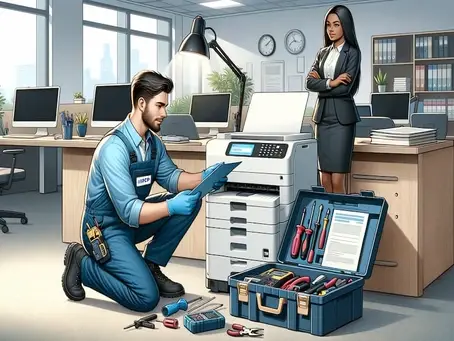How to Empty Toner Waste Container of Printer
Printers remain an indispensable tool in both homes and offices in this digital age. Therefore, understanding the importance of printer maintenance is crucial. Regular upkeep ensures that your machine functions optimally and lasts longer. In other words, it’s not just about refilling the ink or replacing the paper. One component that often gets overlooked is the toner waste container. However, it plays a pivotal role in ensuring your printer’s health.
Understanding your printer’s components is the first step to proper maintenance. For instance, the toner waste container might sound like a trivial part, but it’s more significant than you think.

Understanding the Toner Waste Container
What is a toner waste container?
It’s a plastic compartment within the printer or copier designed to collect excess toner that doesn’t make it onto the paper. In other words, it’s where the unused toner, or waste toner, accumulates over time.
Why is it essential to empty it regularly?
Above all, a full waste toner container can cause print errors or even damage the machine. Similarly, if left unchecked, the excess toner can spill inside the printer, leading to more significant issues. Therefore, to ensure your printer or copier runs smoothly, it’s vital to empty and clean this container regularly.
Steps to Empty the Toner Waste Container
Maintaining your printer involves several steps. However, when it comes to the toner waste container, the process is straightforward:

- Opening the front toner door: Begin by accessing the printer’s front. This step exposes the internal components, including the waste toner container.
- Locating the R5 unit (center grey cover): Inside, you’ll find a central grey cover known as the R5 unit. It protects the waste toner container.
- Using the yellow clip locks to pull out the cover: On the R5 unit, there are yellow clip locks. Gently use these clips to remove the cover.
- Identifying the yellow-covered square foam corner: Once the cover is off, locate the yellow-covered foam corner. This part is crucial as it’s where the waste toner resides.
- Emptying the container into a garbage bin: Carefully tip the container, allowing the waste toner to spill into a bin. Ensure you empty as much as possible.
- Cleaning any toner debris: After that, it’s essential to clean any residual toner. Using a soft cloth, wipe away any spills or debris.
- Reinserting the R5 cover and closing the door: Once clean, place the R5 cover back and secure it with the yellow clips. Finally, close the front toner door.
Safety Precautions When Handling Toner
Handling toner, especially when performing tasks like emptying the waste toner container, requires utmost caution. The importance of safety cannot be overstated, and it should always be at the forefront of any maintenance activity.

Importance of Safety When Handling Toner:
Toner, in its essence, is a very fine powder. When mishandled, it can easily spill, scatter, or even become airborne. Once airborne, there’s a risk of inhalation, which can be harmful to one’s health. The particles are so minute that they can lodge in the lungs, leading to potential respiratory issues. Therefore, it’s imperative to handle toner with the utmost care and respect for its potential hazards.
Tips to Avoid Toner Spillage and Inhalation:
Safety is paramount, and there are several measures you can take to ensure you’re protected:
- Work in a Well-Ventilated Area: Good airflow ensures that any airborne toner particles are quickly dispersed, reducing the risk of inhalation. It also helps in dissipating any fumes that might arise from other printer components.
- Wear Protective Gloves: Direct contact with toner can lead to skin irritation for some individuals. Wearing gloves not only prevents this but also ensures a better grip, reducing the chance of accidental spills.
- Immediate Cleanup: In the event of a spill, act quickly. Use a damp cloth to clean up any toner spills to prevent it from spreading further. For larger spills, consider using a specialized vacuum designed for toner cleanup.
- Gentle Handling: When emptying the waste toner container or replacing toner cartridges, avoid shaking or making sudden movements. A gentle approach minimizes the risk of toner becoming airborne or spilling.
Regular maintenance, especially emptying the toner waste container, is crucial for your printer’s longevity and performance. By following the steps above and prioritizing safety, you ensure that your machine remains in top condition.
Benefits of Regularly Emptying the Toner Waste Container
Maintaining any device, especially a printer, requires careful attention to detail. One such detail is the waste toner box. Let’s dive into the benefits of regularly emptying this component:
Prolonged Printer Life:
Just like how changing the oil can extend a car’s lifespan, emptying the waste toner container can prolong your printer’s life. Accumulated waste toner can cause internal damage, affecting the printer’s functionality. Therefore, regular maintenance ensures your device functions correctly for years.
Improved Print Quality:
Over time, excess toner can interfere with the printing process. By ensuring the waste toner container is not overflowing, you guarantee top-notch print quality. In other words, your documents will always look sharp and professional.
Cost Savings:
Maintenance might seem like an added cost. However, in the long run, it saves you money. Proper care reduces the need for frequent repairs or replacements. In addition, by following a step-by-step guide, you can empty the waste toner container yourself, avoiding technician fees.
Signs That Your Toner Waste Container Needs Emptying
Recognizing the signs is the first step in proper printer maintenance. Whether you have a Xerox AltaLink, Sharp, or another model, it’s essential to be aware of the indicators that it’s time to empty your waste container. Here’s a detailed walk-through of the signs:
Warning Messages:
Modern printers and copiers, especially models like the Xerox AltaLink, come equipped with display screens that generate error messages. One such message you might encounter is a notification that the waste toner box or xerox waste toner container is full. It’s crucial to regularly check the display screen for such alerts. If you’re unsure about interpreting the error message, you can always consult the printer’s instruction manual or click here to be taken to a step-by-step guide on understanding printer alerts.
Poor Print Quality:
If you notice that your prints are streaky, faded, or not as sharp as they should be, it might be due to an overflowing waste toner container. Excess toner, especially in devices like the Xerox AltaLink, can affect the printing process. In other words, the excess toner might be interfering with the proper functionality of the printer, leading to subpar prints. It’s always a good idea to ensure that the waste container is not full before diving into other troubleshooting methods.
Unusual Printer Noises:
Printers and copiers are generally designed to operate quietly. However, if your device starts making strange noises or sounds different than usual, it could be a sign that the toner waste is interfering with the printer’s internal gears or other parts. This might be especially true if you’ve recently replaced the toner cartridges or added new toner. It’s essential to be careful and ensure that the waste toner doesn’t spill within the printer, as this can lead to even worse complications.
In addition to the above signs, if you’re on a lease contract for your printer or copier, the provider might have specific guidelines on maintenance and waste disposal. It’s always a good idea to read through the contract or consult with the provider to ensure you’re following the correct method to emptying your Xerox or any other brand’s waste toner container.
Regular maintenance, including emptying the waste toner container, is crucial for the optimal performance of your printer or copier. By being attentive to the signs and following the proper steps, you can ensure that your device functions safely and efficiently.
What People Also Ask
How often should I empty the toner waste container? The frequency varies depending on the printer model and usage. However, it’s best to check the container monthly. If you notice it’s nearing capacity, it’s time to empty it.
Can I reuse the toner waste container after emptying? Some models allow for reuse, while others recommend replacement. Always consult your printer’s instruction manual or manufacturer’s website for guidance.
What should I do if I spill toner while emptying the container? Toner is a fine powder, so be careful during disposal. If you spill, clean the area immediately using a damp cloth. For larger spills, consult tech support or refer to your printer’s manual.
Conclusion
Maintaining your printer is more than just a routine task; it’s an investment in its longevity and efficiency. Regular maintenance, with a particular focus on the waste toner container, stands out as a crucial aspect of this care. Whether you’re working with a Xerox AltaLink, a Sharp model, or any other brand, the foundational principles of care are universal.
By diligently emptying the waste toner container, you’re not only ensuring crisp, high-quality prints but also extending your device’s lifespan and optimizing cost-efficiency. In essence, being proactive and attentive to your printer’s needs today will undoubtedly save you from potential hassles and expenses in the future.
TitanOfficeSolutions
Phone: (704) 741-0821
Email: info@titanofficesolutions.com
Hours of Operations: Monday through Friday from 8:30 AM to 6 PM EST.
Website: titanofficesolutions.com

